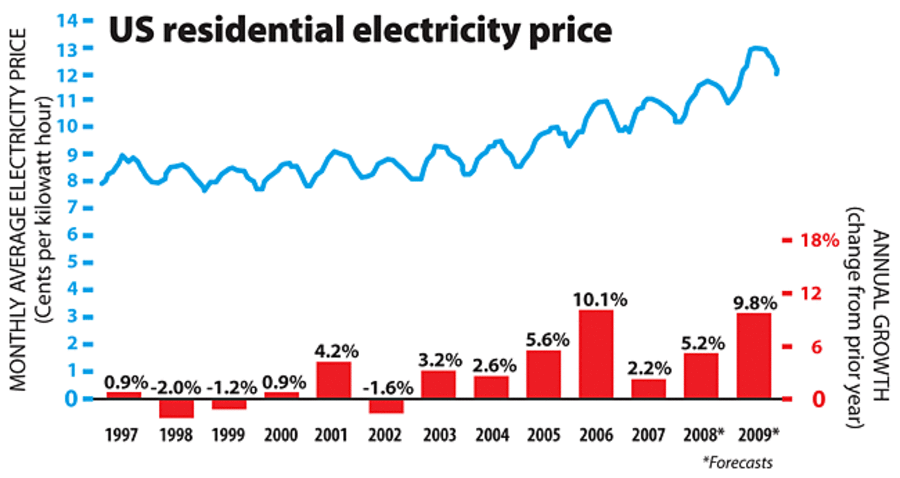Fuel cost now driving up electric bills
Loading...
| New York
Rising energy prices are now squeezing consumers from a different direction: their utility bills.
Consumers from California to New York are facing rate increases of as much as 30 percent. Average homeowners' electric bills are now heading towards $70 to $80 a month in some states. And low- and middle-income residents are having trouble paying their bills as evidenced by a large increase in disconnect notices.
"Electricity's been cheap for a long time, it's just catching up," says Mark Wolfe, executive director of the National Energy Assistance Directors' Association in Washington.
On a national basis, the federal Energy Information Administration (EIA) estimates that electric bills will rise 5.2 percent this year. But next year, they're expected to rise 9.8 percent.
"In the last two months, 20 to 30 utilities started requesting to have their rates increased," says Tyler Hodge, an electricity analyst at EIA in Washington. "With the rise in fuel costs, other utilities will follow suit pretty soon."
The fuel cost that has risen the most so far is natural gas, up about 40 percent in the past year. Last year at this time, the spot price of natural gas was $6 per million BTUs. Thursday morning, the price was $9.85 per million BTUs. In early July it reached as high as $13.31.
The rising price of natural gas is one of the reasons why Southern California Edison, the largest utility in California, recently warned customers it would be requesting a sharp increase in rates. Mid to high use residential customers can expect a rate hike in excess of 30 percent. For their overall system of 4.8 million customers, the average rate increase will be 25 percent.
"On August 1, we normally make a filing to the California Public Utilities Commission that will highlight what we feel our fuel and power costs will be," says Gil Alexander, a spokesman for the utility. "Last week we issued an early warning because of spiking natural gas prices."
The giant utility uses natural gas for 60 percent of the energy that it generates or buys since it is one of the cleanest fuels. "The price has doubled over the last twelve months, and we are quite vulnerable," says Mr. Alexander.
But, coal has also been climbing. In the past 18 months, the spot price of coal has doubled, says Jim Owen of the Edison Electric Institute, which represents the investor-owned utilities in Washington.
"One of the main drivers is global demand. People, especially in China and India, are buying coal here. And in the US, demand for coal continues to grow," he says.
The increasing price of coal is showing up in filings for fuel adjustments. For example, American Electric Power (AEP) recently filed for a 12 percent increase for its Appalachian Power subsidiary that services 500,000 customers in western Virginia.
Not only are coal prices rising, but utilities are now asking for rate increases for the equipment they have installed to remove pollutants from power plant smokestacks. AEP, which operates in eleven states, has asked for a 17 percent rate increase in West Virginia partly to pay for the new emission reduction equipment.
Some of the rate increases reflect the rising cost of commodities such as copper and the rising cost of gasoline and diesel for utilities' large vehicle fleets.
Utilities are trying to pass on these rising expenses. For example, AEP in Virginia has asked for a 24 percent increase (on top of the 12 percent fuel adjustment). "Power poles are up 39 percent since 2003, copper wire has more than doubled since then," says AEP spokeswoman Melissa McHenry in Columbus. Ohio.
Not all of the rate increases are in the double digit range. There are also many smaller 3 to 4 percent increases such as 4.5 percent at Pacific Gas & Electric, 2.5 percent at ComEd in Chicago and 2.85 percent at Connecticut Light & Power.
Tyson Slocum of Public Citizen says his organization has found rate increases are higher in deregulated utility markets.
"In a deregulated market, the prices are set by the cost of the last kilowatt of power," he says. "In a fully regulated market, prices are set by the average of all costs."
However, John Shelk, the president of Electric Power Supply Association, which argues for utility deregulation in Washington, says his organization's surveys have found the rate of increase is the same for both regulated and deregulated utilities. The difference is that regulated utilities face a lag in getting back their rising fuel costs.
"The rate of increase (of the price of electricity) is 30 percent in both deregulated and regulated types of states," he says.
In the June Consumer Price Index, the Bureau of Labor Statistics found natural gas and electric prices were 10 percent higher than a year ago. Washington-based economist Richard DeKaser of National City Corporation estimates the rising rates have trimmed about 0.5 percent off household discretionary income. "If it's in isolation, it's manageable," he says. "But it's not in isolation, it's part of a larger trend of rising energy prices."
In fact, for some consumers the utility rate hikes are just too much. "In the summer it used to be that 1 percent to 2 percent of consumers were shut off for not paying their bills, now it's in the range of 5 percent," says Mr. Wolfe of NEADA, which lobbies for federal aid to help low income families with their heating and air conditioning bills. "What's happened is that it's moved from a problem for the poor to the middle class. When people are living paycheck to paycheck higher energy costs become more significant."



